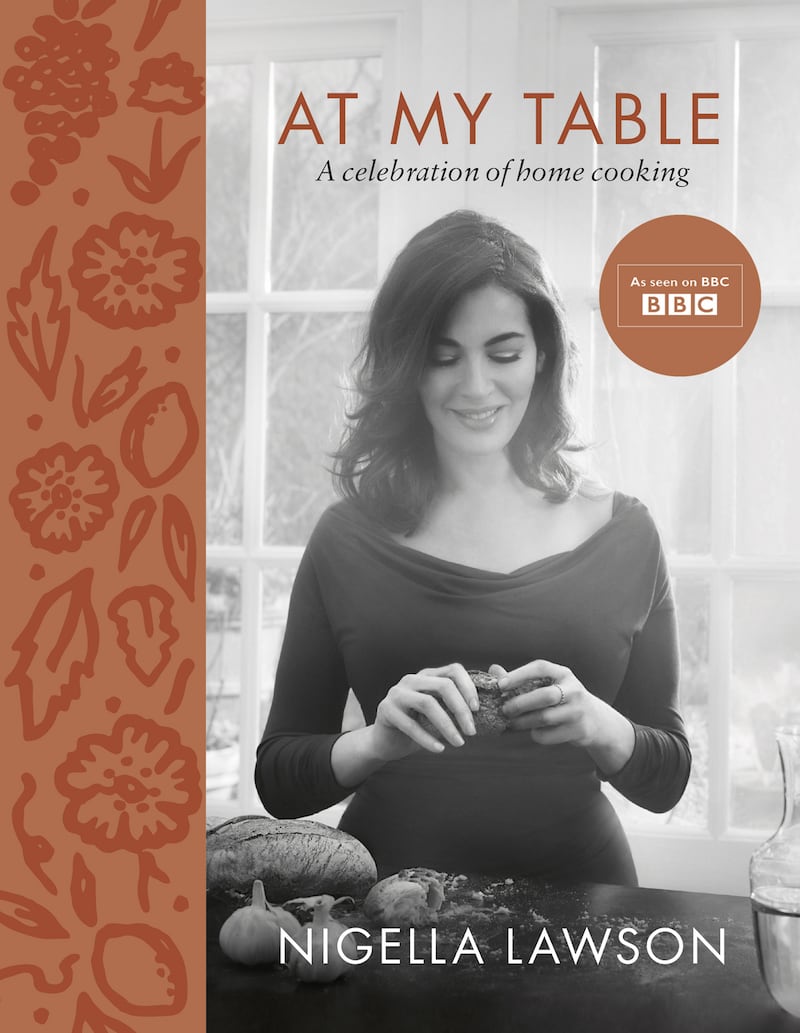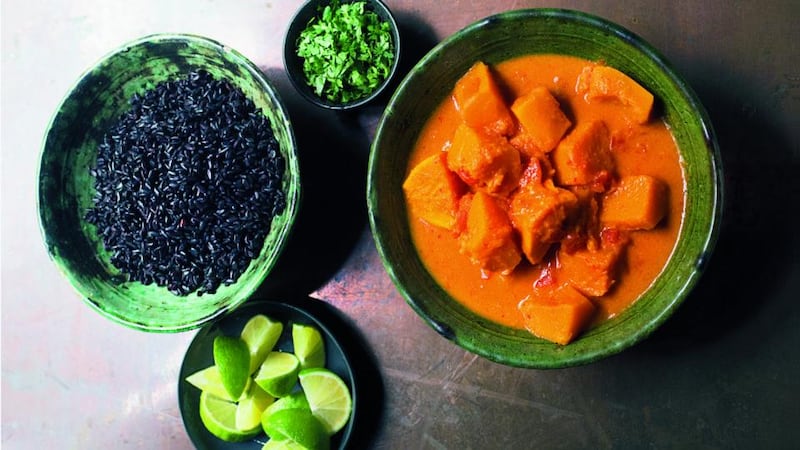The very first thing food writer and broadcaster Nigella Lawson bought when she moved into her first home was a table – “a table not just to eat on, but to live around”, she says. “A table is more than a piece of furniture, just as food is more than fuel.”
It is fitting, then, that her new cookbook is a collection of dishes from her own kitchen, eaten at her table, shared with family and friends, and now set to inspire a return to the table for a generation in danger of losing grasp of the many pleasures of a meal shared, at table.
At My Table: A Celebration of Home Cooking is Lawson's 11th cookery book. The 57-year-old has written a cookery book "every other year since 1998", with a couple of exceptions. This one will be accompanied by a six-part TV series on BBC2, to be screened at the end of next month.
“Our lives are formed by memories, and the focus of mine is the food I’ve cooked and the people I’ve cooked for, the people who have sat at my table, as well as the other tables I’ve eaten at, from the blue formica table of my childhood, to the mottled zinc one that is the nexus of my life now.”
That zinc table that Lawson refers to is to be found in her London home. "I cook for my children probably most of all, but I love feeding anyone," she tells The Irish Times, referring to her daughter Cosima (23) and son Bruno (21), her children with the journalist John Diamond, who died of throat cancer nine years into their marriage in 2001.

“Of course, the big occasions in life are important, but for me the everyday is what life is about, so my memorable meals are not about the big blowout meals or one-off events,” she says, when asked about the meals that live on in her thoughts.
“The first memory that comes to mind is a weekend lunch when I was a child, probably around six, and as ever my mother has roasted a chicken with a half a lemon inside it. Actually, my mother has roasted two chickens, as part of the point is to have a lot of cold leftovers later. There are green beans and cabbage, too, both crunchy and peppery and tossed with a lot of golden butter. And there is a big bowl of boiled potatoes, another repository for a lot of melted butter and freshly ground white pepper.
Strained relationship
She has said that she had a strained relationship with her mother, Vanessa, who died of liver cancer at the age of 48, when Lawson was 28.
“Actually, as a child I did find eating and mealtimes difficult, and I remember this both fondly, as remembering my mother’s food is a way of remembering her, but also it’s a slightly tense memory as I remember how I felt at the time. But it’s important to be true to both the good and the bad: food is so much part of the fabric of my life, and I would never want to distort a memory. I am not a sentimental person, for sure.
And a more recent example of a memory informed by food? "I'd nominate a big supper at home, with my children and some very good friends and their children, all of us around a table as we have been – whether at their house or mine – over the last two decades. I've got my Ikea tea lights on the table, and flowers in my little vintage milk bottles, and we're eating my chicken and pea tray-bake with some garlic and Parmesan mash, and a vast crunchy salad. And for pudding, there is my chocolate amaretto cake. It's a simple At My Table feast."
When it comes to inviting others to share your table, in an intimate or an extended way, Lawson is all about fuss-free, relaxed food.
“Like many people, I do have things I fall back on regularly, and my chicken tray-bake meal is no one-off. When I plan what to cook, it’s often something I know I can rustle up easily without too much warning. So I’ll make a big vat of Italian sausage and saffron sauce, put some in the fridge, and freeze some, and then all I have to do is cook pasta and heat up the sauce when hungry people appear.
“And I always keep the ingredients for my butternut and sweet potato curry, as I just adore it, and it’s very handy when I need a vegetarian (actually, this is vegan) meal on the table, and I find I often do.
"If I have a vegetarian to supper, I like to make the whole meal vegetarian, not just provide a veggie option. But most often, I am just rummaging about the fridge and using up what's there. Actually, quite a few the recipes in At My Table came to be in the first instance because of the ingredients I happened to have to hand when I needed to cook something. But that is the absolute essence of home cooking."
Feeding a posse
Keeping it simple is good advice, but sometimes we want to feed a posse, and hope to impress them a little along the way too. It’s party week here in these pages, so what does Lawson cook when she entertains a big number, say a gang of 20 friends?
“That so depends on what the occasion was, but I certainly think it makes life very much easier if you can cook a lot of it ahead, and you don’t need to do much last minute. I don’t actually have any recipes for 20, but my butternut curry would be easily scaled up, though I’d maybe take a chilli out to make it appealing to those who didn’t like too much heat, too.
“And I’ve got a couple of lamb recipes that I tend to do when feeding a crowd. I’ve got a recipe for lamb shanks with dates and pomegranate molasses, and when I have lots of people, I cook it ahead and then strip the meat off the shanks, which makes it go very much further.
"I'd double the recipe in At My Table for 20 people. And I've got a gorgeous recipe for spiced lamb (and here I use neck) with potatoes and apricots. Both of them could be ladled out very happily and easily for a crowd. And for pudding, I'd whip up a few white chocolate cheesecakes, which are very easy and you can get done a couple of days earlier for ease."
Make them feel welcome
That’s the food sorted, but what else can we do to make throwing a party a pleasure, not a pain?
"I think the most important thing is to remind yourself that people are coming to have a good time, not to judge, and you just need to make them feel welcome. In other words, do not feel you have to cook as if you're in the final of MasterChef. Simple is best.
“Choose something you feel confident with, and that doesn’t need tending all evening, and if you need help, ask for it. I often ask a girlfriend to come early to help me with that last-minute fussing before people turn up. And never wear new shoes!”

Never be afraid to ask for help, or an opinion, is good advice, and it is something Lawson does in her own life – although she freely admits she doesn’t always heed it. Unlike some cookbook authors whose recipes are ghostwritten, or constructed by teams of support staff, Lawson is a team of just two, when it comes to thinking up, tweaking and testing recipes.
"I don't have a team, but I do have one person who cooks with me, Hettie Potter, who came to work for me for a month in January 1999, and has been with me ever since. Often what this means is that I cook and she writes down what I'm doing – and this is incredibly helpful, as it can be difficult to be spontaneous and take notes at the same time, though I do sometimes try and do that, as of course I'm often cooking when Hettie isn't working.
“At other times, I might have cooked something and decided it needs tweaking, and we might cook it again together. I find it very helpful to have someone to discuss decisions with, though I drive her mad, as I ask her what she thinks and then ignore her answer and go with my own decision. But sometimes disagreeing with someone is the best way of knowing what you think yourself, and I always have to feel a decision, a recipe, is right for me and for my palate.”
Stream of consciousness
At My Table follows an unusual format for a cook book. There are no chapters, no formal groupings of recipes; it's more like a stream of consciousness, though there is a narrative flow that will make perfect sense to anyone who cooks.
“I can only ever write the book I want to write, and for me the structure of a book is an essential part of its personality. For me, a sense of freedom and flow was at the heart of the book, and right from the beginning, before I’d written a word, I knew it had to be like this, without chapters or divisions, just a run of recipes,” Lawson says.
She says she finds writing cookery books challenging, “but whereas in life generally I do not like challenges, I relish it when it comes to a book. It’s necessary. I think if anything is worth doing, it is a little frightening. It’s just important that it is not so frightening that all the joy is taken away.”
Joy is such a recurring theme in Lawson's writing, and in her food, that The Joy of Cooking might well be an alternative title for this book. It's evident that she derives great enjoyment from her work.
“Apart from the pleasure of eating, which is immense, and lasts longer than any particular meal, for me food is such a rich subject. I like the research, the social history of food, as well as the finding out about the particular use of ingredients and the evolution of recipes.
“I find food very beautiful, too, and we all need beauty in our lives. Walking around a market, looking at a bowl of lemons on my table, seeing the colours of food in the pan as I cook: all these things make the moment better; they are uplifting experiences.
“I also find cooking a great way of decompressing. I like the physicality of it. Many of us live too much in our heads, and living through our hands can quieten the mind. (This is why some people love gardening, as well.)
“I am talking about simple, everyday cooking here. I am not talking about the sort of cooking when there is pressure to perform, which is not relaxing in the slightest. And I have a deep need to feed people. And maybe there is a control issue, too: I just couldn’t be at the mercy of other people when it came to my own sustenance. For me, cooking for myself is such an essential act of independence.
Readers’ favourite dish
Asked to speculate on what will become the readers' favourite recipe from this collection, in the way that sweet potato mac'n'cheese did in her previous book, Simply Nigella, she says: "That's an impossible question to answer – and that's a good thing. By that I mean, I feel that every recipe has the potential to be that, but only because I don't put a recipe in a book unless I really love it. But I have never sat down and tried to work out what would be most popular and tried to make up a recipe accordingly. I'm not strategic at all. I just go by my own enthusiasms.
"All books have lives of their own, and it's impossible to judge in advance what will be the most popular recipes. I'd say that from At My Table, the chicken and pea tray-bake, the butternut and sweet potato curry, the ginger and walnut carrot cake are immediate contenders, but as soon as I say that, I think of all the other recipes in the book I make again and again."
NIGELLA LAWSON'S BUTTERNUT AND SWEET POTATO CURRY

This is a rambunctiously vibrant curry, both to look at and eat.
It is rich, sweet and hearty, with tomatoes providing a balancing acidity and the curry paste bringing uncompromising fire. Of course chillies do vary in heat, so if you’re after something a little less passage-clearing, use two rather than three, and if you want to go milder still, simply deseed the chillies. Having said that, cooking with chillies always has a touch of roulette about it.
While I have indicated to add the creamy top bit of the coconut milk first, I have to say that I all too often, not paying attention, open the tin upside-down, so don’t worry too much about it, but still add just a little of the coconut milk first, stirring it into the pan with the paste, before pouring in the rest.
I like the drama of black Venus rice with this, but by all means serve any rice you want alongside.
1 Blitz the prepared onion, chillies, ginger, garlic, turmeric, ground coriander, cinnamon and salt to a paste with a stick blender.
2 Heat the coconut or vegetable oil in a wide, heavy-based casserole that has a lid, and then fry the paste for about a minute or so, stirring well. Don't use a wooden spoon unless you don't mind it being stained by the turmeric.
3 Open the tin of coconut milk carefully and then scrape off the creamy top into the paste, stirring everything together over the heat for another minute or so before adding the rest of the tin of coconut milk, followed by the stock, tinned tomatoes, then the chunked sweet potato and butternut.
4 Give a good stir, bring to the boil and, once bubbling, turn down the heat, and when everything is gently simmering, clamp on the lid and cook for 40–50 minutes (though start checking at 30) until the sweet potatoes are soft and the squash cooked through. Check for seasoning, then leave to stand off the heat for 10 minutes or so before serving.
5 Eat with the rice and put chopped coriander and lime wedges on the table alongside, for sprinkling and spritzing respectively
- Extracted from At My Table by Nigella Lawson, published by Chatto & Windus at €23.99. Copyright Nigella Lawson 2017. Photograph copyright Jonathan Lovekin











